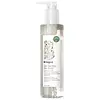What's inside
What's inside
 Key Ingredients
Key Ingredients

 Benefits
Benefits

 Concerns
Concerns

 Ingredients Side-by-side
Ingredients Side-by-side

Water
Skin ConditioningSodium C14-16 Olefin Sulfonate
CleansingCocamidopropyl Hydroxysultaine
CleansingCocamide Mipa
EmulsifyingPanthenol
Skin ConditioningSpirulina Platensis Extract
Skin ProtectingChondrus Crispus Extract
Skin ConditioningLactobacillus Ferment
Skin ConditioningSteareth-4
EmulsifyingLaureth-4
EmulsifyingLaureth-23
CleansingQuaternium-80
Polyquaternium-44
Propylene Glycol
HumectantCinnamidopropyltrimonium Chloride
Glycol Stearate
EmollientGlycol Distearate
EmollientPEG-150 Distearate
EmulsifyingHydroxypropyl Guar Hydroxypropyltrimonium Chloride
Dimethicone
EmollientEthylhexylglycerin
Skin ConditioningMagnesium Nitrate
Magnesium Chloride
Sodium Chloride
MaskingTetrasodium EDTA
Sodium Hydroxide
BufferingCitric Acid
BufferingSalicylic Acid
MaskingPhenoxyethanol
PreservativeChlorphenesin
AntimicrobialSodium Dehydroacetate
PreservativeMethylchloroisothiazolinone
PreservativeMethylisothiazolinone
PreservativeParfum
MaskingWater, Sodium C14-16 Olefin Sulfonate, Cocamidopropyl Hydroxysultaine, Cocamide Mipa, Panthenol, Spirulina Platensis Extract, Chondrus Crispus Extract, Lactobacillus Ferment, Steareth-4, Laureth-4, Laureth-23, Quaternium-80, Polyquaternium-44, Propylene Glycol, Cinnamidopropyltrimonium Chloride, Glycol Stearate, Glycol Distearate, PEG-150 Distearate, Hydroxypropyl Guar Hydroxypropyltrimonium Chloride, Dimethicone, Ethylhexylglycerin, Magnesium Nitrate, Magnesium Chloride, Sodium Chloride, Tetrasodium EDTA, Sodium Hydroxide, Citric Acid, Salicylic Acid, Phenoxyethanol, Chlorphenesin, Sodium Dehydroacetate, Methylchloroisothiazolinone, Methylisothiazolinone, Parfum
Water
Skin ConditioningSodium Lauroyl Methyl Isethionate
CleansingCocamidopropyl Betaine
CleansingGlycerin
HumectantAloe Barbadensis Leaf Juice
Skin ConditioningAvena Sativa Bran Extract
AbrasiveCamellia Sinensis Leaf Extract
AntimicrobialLimnanthes Alba Seed Oil
Skin ConditioningPanthenol
Skin ConditioningSodium Gluconate
Skin ConditioningCitric Acid
BufferingLeuconostoc/Radish Root Ferment Filtrate
AntimicrobialPanthenyl Hydroxypropyl Steardimonium Chloride
Tocopheryl Acetate
AntioxidantPotassium Sorbate
PreservativeSodium Benzoate
MaskingCaprylhydroxamic Acid
Benzyl Alcohol
PerfumingWater, Sodium Lauroyl Methyl Isethionate, Cocamidopropyl Betaine, Glycerin, Aloe Barbadensis Leaf Juice, Avena Sativa Bran Extract, Camellia Sinensis Leaf Extract, Limnanthes Alba Seed Oil, Panthenol, Sodium Gluconate, Citric Acid, Leuconostoc/Radish Root Ferment Filtrate, Panthenyl Hydroxypropyl Steardimonium Chloride, Tocopheryl Acetate, Potassium Sorbate, Sodium Benzoate, Caprylhydroxamic Acid, Benzyl Alcohol
Ingredients Explained
These ingredients are found in both products.
Ingredients higher up in an ingredient list are typically present in a larger amount.
Citric Acid is an alpha hydroxy acid (AHA) naturally found in citrus fruits like oranges, lemons, and limes.
Like other AHAs, citric acid can exfoliate skin by breaking down the bonds that hold dead skin cells together. This helps reveal smoother and brighter skin underneath.
However, this exfoliating effect only happens at high concentrations (20%) which can be hard to find in cosmetic products.
Due to this, citric acid is usually included in small amounts as a pH adjuster. This helps keep products slightly more acidic and compatible with skin's natural pH.
In skincare formulas, citric acid can:
While it can provide some skin benefits, research shows lactic acid and glycolic acid are generally more effective and less irritating exfoliants.
Most citric acid used in skincare today is made by fermenting sugars (usually from molasses). This synthetic version is identical to the natural citrus form but easier to stabilize and use in formulations.
Read more about some other popular AHA's here:
Learn more about Citric AcidPanthenol is a common ingredient that helps hydrate and soothe the skin. It is found naturally in our skin and hair.
There are two forms of panthenol: D and L.
D-panthenol is also known as dexpanthenol. Most cosmetics use dexpanthenol or a mixture of D and L-panthenol.
Panthenol is famous due to its ability to go deeper into the skin's layers. Using this ingredient has numerous pros (and no cons):
Like hyaluronic acid, panthenol is a humectant. Humectants are able to bind and hold large amounts of water to keep skin hydrated.
This ingredient works well for wound healing. It works by increasing tissue in the wound and helps close open wounds.
Once oxidized, panthenol converts to pantothenic acid. Panthothenic acid is found in all living cells.
This ingredient is also referred to as pro-vitamin B5.
Learn more about PanthenolWater. It's the most common cosmetic ingredient of all. You'll usually see it at the top of ingredient lists, meaning that it makes up the largest part of the product.
So why is it so popular? Water most often acts as a solvent - this means that it helps dissolve other ingredients into the formulation.
You'll also recognize water as that liquid we all need to stay alive. If you see this, drink a glass of water. Stay hydrated!
Learn more about Water